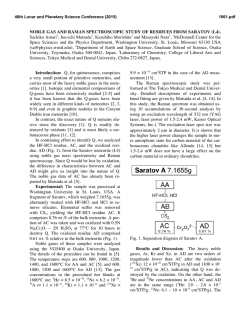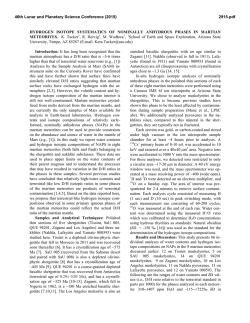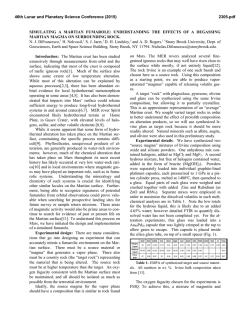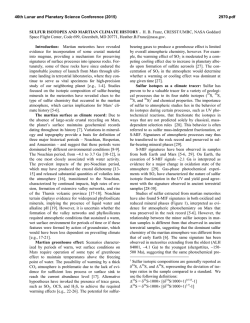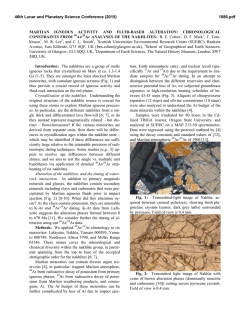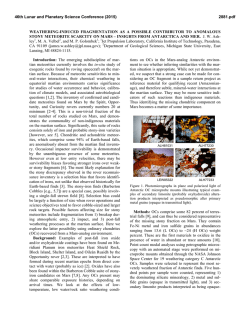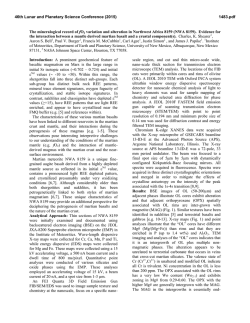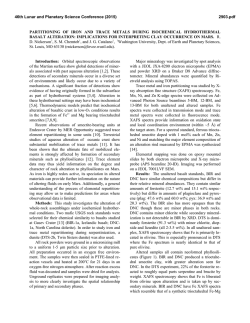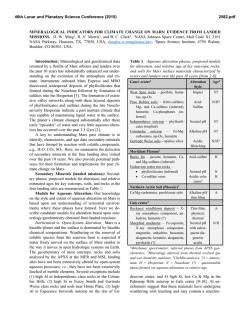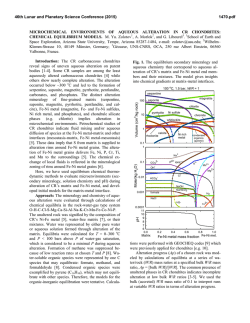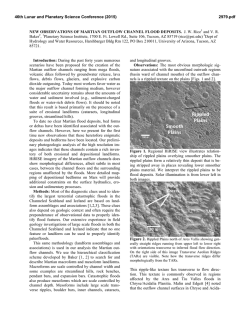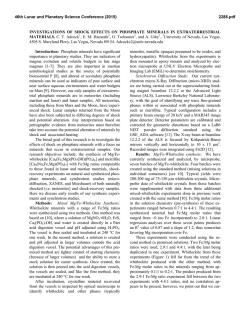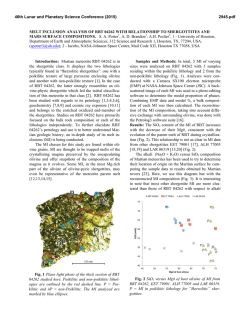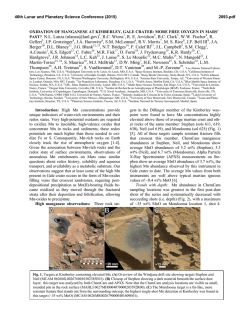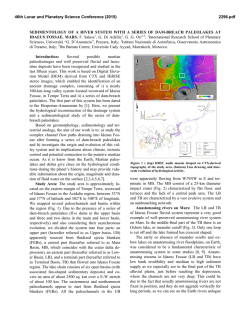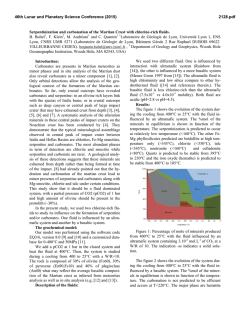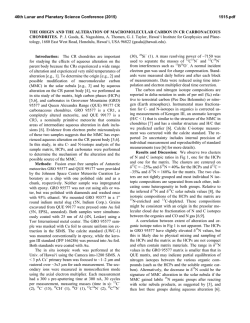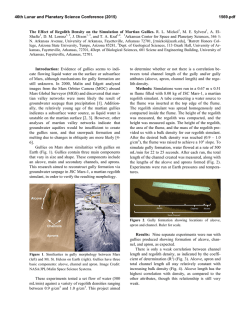
Noble Gas Fractionation During Low Temperature - USRA
46th Lunar and Planetary Science Conference (2015) 1235.pdf NOBLE GAS FRACTIONATION DURING LOW TEMPERATURE ALTERATION - AN EXPERIMENTAL APPROACH. M. A. Bullock1, S. P. Schwenzer2, J. C. Bridges3, C. Chavez4, J. Filiberto5, S. P. Kelley2, M. Miller6, J. M. Moore4, H. Smith4, T. D. Swindle7, A. H. Treiman8 – 1Southwest Research Institute, 1050 Walnut St., Suite 300, Boulder, CO 80302 ([email protected]); 2The Open University, Walton Hall, Milton Keynes MK7 6AA, UK; 3Space Research Centre, University of Leicester, UK, 4NASA Ames Research Center, MS 245-3, Moffett Field, CA 94035; 5Southern Illinois University, MC 4324, Carbondale, IL 62901; 6Southwest Research Institute, 6220 Culebra Road, San Antonio, Texas 78228; 7University of Arizona, Tucson, AZ; 8Lunar and Pleantary Institute, 3600 Bay Area Blvd, Houston, TX 77058. Introduction: The heavy noble gases (Ar, Kr, Xe) are key tracers of planetary outgassing, atmospheric formation, and atmospheric evolution. On Mars, at least 3 distinct noble gas signatures have been observed: (1) Noble gas ratios different from the curent Mars atmosphere, but derived from mantle sources, was first found in Chassigny [1]. (2) Shergottites, especially their shock glasses, contain unfractionated Martian atmosphere [e.g., 2-4]. (3) The nakhlite Martian meteorites and the ortho-pyroxenite ALH84001 contain fractionated Martian atmosphere that has been explained through several possible mechanisms: (1) The fractionation could represent ancient Martian atmosphere with a noble gas signature different from today [5-8]. (2) The elementally fractionated noble gases could have entered the rocks via magma, either as a crustal component or via magmatic assimilation of aqueously altered crustal rock [9-12]. (3) The elementally fractionated noble gases could have entered the rock during the formation of aqueous alteration minerals [1,13-19]. Using data from Lafayette ‘iddingsite’, pure pyroxene mineral separate and whole rock samples, we have previously calculated that such an aquously fractionated component could have a 84 Kr/132Xe of ~8 [15]. All meteorites that show a fractionated Martian atmospheric component contain alteration products. Carbonates are the main alteration product in ALH 84001, accompanied by magnetite (e.g., [20-23]). In the nakhlites several alteration phases have been found [24,25]; Lafayette contain carbonates, clay (ferric saponite, serpentine), sulfides, and an amorphous component [26,27]. Experimental Rationale and Plan: The primary goal is to understand how the fractionated noble gas fingerprint become incorporated into the nakhlite Martian meteorites. We are carring out several longduration experiments under controlled (Mars-like) atmosphere and constant temperature. Past experiments on a variety of Martian rock compositions, have successfully produced Martian alteration products and fluids [28-33]. However, those experiments did not include any specified noble gas concentration and the samples were dried in an Ar stream. In this new study, we will expose a range of Martian rock compositions - as mineral mixes and glasses - to a synthetic Martian atmosphere that contains 2% Ar, 30 ppm Kr and 8 ppm Xe. This will allow us to test the extent of noble gas fractionation via a two-step process: dissolution in the fluid, followed by potential incorporation in the alteration phases. Our 4 experimental runs will include the following starting materials and conditions: Run 1 (current): 1 month, 35°C, set of single minerals (olivine, pyroxene and plagioclase, and mineral mixtures, see below), Mars gas with noble gases; Run 2: 1 year, 35°C, optimized mineral mixtures to match the nakhlite meteorites and rock compositions found in Gale Crater; Run 3: ½ year, acid added run, 35°C, ‘simple’ Martian magmatic host rock mineralogy and glassy starting material; Run 4: 1 year, 35°C, Mars gas with noble gases, glasses that match a variety of Martian rock compositions (nakhlites, Gusev and Gale rock compositions or their magmatic precursors). In a second strand of this research, we will model the alteration assemblages for which we will know the composition of all inputs: experiment temperature profile, the headspace gases, and the starting mineralogy. This will allow us to refine thermochemical models of clay minerals, which are especially challenging because of the lack of thermochemical data at low temperatures [34]. Experimental Set Up: We will use the Mars brines experimental apparatus at NASA Ames [28], which allows the controlled long-term exposure of minerals in fluids to an artificial atmosphere (Fig. 1). Figure 1. Schematic diagram of a glove box of the Mars Aqueous Simulation Facility. 46th Lunar and Planetary Science Conference (2015) 32 sample vessels containing purified water and Mars-analog rocks or controls sit in a temperaturecontrolled aluminum pallet (1.0 °C). The vessels and pallet reside in a glovebox which is periodically purged with pure CO2 and has pressure slightly higher than ambient to prevent air contamination. A closedloop pressure sensor/solenoid valve system feeds the chosen head gas into the sample containers at slightly higher pressure than the glovebox CO2. The head gas is humidified in the glovebox before reaching the sample vessels. Pressures and temperature are controlled, monitored, and logged continuously. Mineralogical Compositions: The 1 month run contains 6 different samples: A: olivine, B: plagioclase, C: pyroxene, D: olivine + plagioclase (1:1), E: pyroxene + plagioclase (1:1), F: olivine + plagioclase + pyroxene (2:1:1). For mineral chemistry see [30]. The samples are loaded into 18 vessels in the order AB-C-D-E-F- A-B-C-D-E-F-F-E-D-C-B-A to detect any differential in reaction rates that might occur along the water-saturated gas circuit. Analyses: We will measure the fluid chemistry, identify alteration products, and obtain noble gas abundances in alteration produces Models: In parallel, we will model all six experimental reactions using the code CHIM-XPT [35]. We will use mineral compositions as reported in [30] and react those with pure water equilibrated with 1 bar of CO2 atmosphere. The model temperature is the experimental temperature, 35 °C. We will discuss the solid phase mineralogy, fluid chemistry, and noble gas content of the products of our 1 month pilot run (Run 1), as well as the initial modeling efforts. Future work: The next phase will include a mineralogy-focused run, which will include some pieces of San Carlos olivine with polished surfaces and depthprofiling of alteration and noble gas adsorption. Future, glass-based runs will be used to better adjust the chemistry of the dissolving material to Martian rock compositions. Models will be constructed to match each alteration condition - and a comparison of the run products with the models will be carried out. We will thus characterize the fluid, degree of alteration (and the water to dissolved rock ratio), alteration assemblage, and the noble gas inventory. The aim of the work is to produce a unique data set of alteration products and their noble gas fingerprints, which we can then compare with the nakhlite Martian meteorite noble gases, and any potential measurement of noble gases on Mars by the Curiosity rover [36]. For example, Curiosity measurements of noble gases in mudstones drilled in Gale crater have yielded both the radiometric K-Ar age 1235.pdf of primary crater material and the cosmogenic exposure age of the mudstone [37]. Interpretation of in situ K-Ar dates depends crucially on the provenance of K in the measured samples. Noble gases in authogenic materials may be fractionated by the later processes that created them. We will discuss how our experimental results can be used to improve K-Ar age interpretations of detritus/authogenic mixtures. References: [1] Ott 1988 [2] Bogard and Johnson (1983): Martian Gases in an Antarctic Meteorite? – Science, 221: 651–654, [3] Bogard, D. D. & Garrison, D. H. (1998): Relative abundances of argon, krypton, and xenon in the Martian atmosphere as measured in Martian meteorites.– Geochim. Cosmochim Acta., 62: 1829–1835. [4] Swindle, T. D. (2002), Reviews in Mineralogy & Geochemistry 47: 171– 190. [5] Gilmour et al. (1998) Meteorit. Planet. Sci. 33, A59. [6] Mathew and Marti (2002) Meteorit. Planet. Sci. 33, 655– 664. [7] Musselwhite and Swindle (2001) Icarus 154, 207– 215. [8] Swindle et al. (2009) Lunar Planet. Sci. XL, Abstr. #1660. [9] Gilmour et al. (1999) Earth Planet. Sci. Lett. 166, 139–147. [10] Gilmour et al. (2001) Geochim. Cosmochim. Acta 65, 343–354. [11] Mathew et al. (2003) Earth Planet. Sci. Lett. 214, 27–42. [12] Mathew and Marti (2005) J. Geophys. Res. 111, E12S05. [13] Drake et al. (1994) Meteoritics 29, 854–859. [14] Mohapatra et al. (2009) Geochim. Cosmochim. Acta 73, 1505–1522. [15] Schwenzer and Ott (2006) Lunar Planet. Sci. XXXVII, Abstr. #1614. [16] Ott (2008) Lunar Planet. Sci. XXXIX: Abstr. #1096. [17] Schwenzer et al. (2009) Polar Science, doi:10.1016/j.polar.2009.06.00. [18] Swindle et al. (2000) Meteor. Planet. Sci. 35, 107-116. [19] Cartwright et al. (2013) Geochimica et Cosmochimica Acta, 105: 255–293. [20] Valley, J. W. et al. (1997) Science 275, 1633-1638. [21] Gleason, J. et al. (1997) Geochim. Cosmochim. Acta 61, 3503-3512. [22] Treiman, A. H. (1995) Astrobiology 3, 369392. [23] Golden et al. (2004) Amer. Mineral. 89, 681-695. [24] Gooding, J. L. (1991) Meteoritics, 26: 135–143. [25] Treiman, A. H. (2005) Chem. Erde 65, 203–270. [26] Changela H.C., and Bridges J.C. (2010) Meteoritics and Planetary Science. 45, 1847–1867 [27] Hicks, L. J. et al. (2014) Geochim. Cosmochim. Acta, 136: 194–210. [28] Bullock, M. A., Moore, J. M. (2004) Geophysical Research Letters, 31: doi:10.1029/2004GL019980. [29] Bullock M.A., and Moore J.M. (2005) Lunar Planet. Sci. XXXVI, Abstr # 2203. [30] Bullock M.A., Moore J.M., and Mellon M.T. (2004). Icarus 170, 404-423. [31] Moore J.M., and Bullock M.A. (1999) J. Geophys. Res. 104, 21925–21934. [32] Moore J.M. et al. (2007) Seventh International Conference on Early Mars, Abstr. #3085. [33] Moore J.M. et al. (2008) Lunar Planet. Sci. XXXIX, Abstr. #1955. [34] Bridges et al. (2014) Journal Geophys. Res., in print: 10.1002/2014JE004757. [35] Reed M.H., et al. (2010) Users Guide for CHIM-XPT: A Program for Computing WaterRock Reaction Processes in Aqueous-Mineral-Gas systems and Mintab Guide. 71p.; Oregon (University of Oregon). [36] Mahaffy, P. R., et al. (2013) Space Science Reviews, 170: 401–478. [36] Farley, K.A., et al. (2014) Science, 343.
© Copyright 2025
